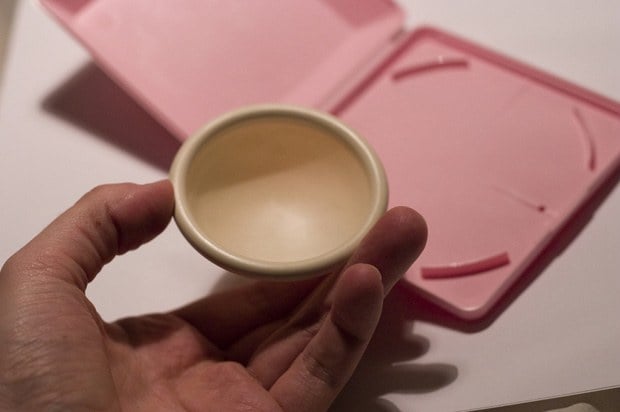Diaphragm contraceptive
Inserting a rubbery cup into your vagina may be an age-old method of contraception, but what is a diaphragm, and how effective is it? And isn’t it a bit messy? We bring you up to speed on the contraceptive diaphragm and caps.

What is a diaphragm?
Contraceptive diaphragms are circular, dome shaped (about the size of your palm) made of thin soft rubber or silicone with a springy, flexible rim.
What is a cap?
Caps are smaller than diaphragms (about the size of an egg-cup). They are more rigid and made of latex or silicone.
How do caps and diaphragms work?
Both caps and diaphragms fit inside the vagina and cover the cervix, stopping sperm from getting inside the womb. They are 92-96% effective at preventing pregnancy (when used correctly, and with a spermicide).
Are all diaphragms the same size?
No. Because vaginas come in all shapes and sizes, diaphragms and caps do too. Your GP or nurse at the family planning clinic will ‘assess your vagina’ before prescribing the perfect one for you.
How easy are diaphragms to fit?
The first time you use a diaphragm or cap you must get it fitted by a doctor or nurse at the family planning clinic. It will take a bit of practice to get the position right, but won’t take long before it becomes as familiar as inserting a tampon. Here’s what you have to do:
- Put a dollop of spermicide in the middle and around the rim – this is essential as effectiveness is reduced without it, and yes, it is a bit messy.
- Get into a position – this can be squatting, lying down or one leg up.
- Press the rim together and push into the vagina as far as it goes.
- Using your fingers, feel that it has covered the cervix – it should feel like the tip of your nose.
- If it feels uncomfortable, take it out and try again
Neither partner should be able to feel it during sex.
When to insert a diaphragm
A diaphragm or cap can be inserted up to three hours before sex (if inserted more than three hours before you will need to use more spermicide) and should be kept in place at least six hours after having sex (but no longer than 30 hours).
You can also use it if you’re feeling horny during your period but your partner’s squeamish about the sight of blood, as there’s usually no sign of a period with a diaphragm in place.
How to remove a contraceptive diaphragm
Simply hook your fingertip round it – your GP or nurse will show you how to do this.
I hate the pill. Should I get a diaphragm?
If you don’t get on with the pill because it messes with your hormones, a diaphragm or cap is a good option. It won’t affect your menstrual cycle, or cause bloating, spots or mood swings. It may also slightly decrease your risk of cervical cancer, compared to taking the pill.
Do you need to use condoms with a diaphragm?
Unless both of you have been tested for STIs and have the all-clear, if your partner has a penis they should still wear a condom. Even if you’re both clear of STIs, it’s best to stick with condoms until you become a pro at inserting your diaphragm or cap.
Are there any risks with diaphragms or caps?
Cystitis can be a problem for some users, but not all. Other potential issues include the possibility of the diaphragm moving due to penis size, sexual position, or heavy thrusting.
Can anyone use a diaphragm or cap for birth control?
Most people can use a diaphragm or cap, however it’s not recommended if you:
- Have poor muscle tone in the vaginal area, (the diaphragm is partly held in place by the vaginal muscles).
- Are sensitive to rubber or spermicide – that goes for your partner, too.
- Suffer from severe and frequent cystitis.
- Have had toxic shock syndrome.
If you’re still looking for advice on contraception, check out the rest of The Mix’s safe sex resources here. We have an article on the different types of contraception here and one on contraceptive pill options here which might be of interest.
FPA also has a free sexual health line, and Brook’s Contraception tool can also help you work out whether a diaphragm, cap or other contraceptive is best for you.
Next Steps
- FPA give sexual health advice. For Northern Ireland helpline call 0345 122 8687.
- Chat about this subject on our Discussion Boards.
By Nicola Scott
Updated on 29-Sep-2015
No featured article










